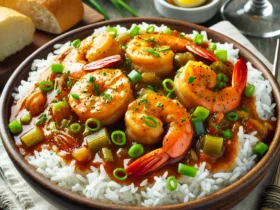Poke bowls have surged in popularity, captivating food enthusiasts worldwide with their vibrant colors, fresh ingredients, and customizable nature. Originating from Hawaii, this dish offers a healthy, delicious, and visually appealing meal option. Whether you’re a seasoned chef or a culinary novice, creating a poke bowl at home is a delightful and rewarding experience. In this article, we’ll explore the history of poke bowls, the essential components, and a step-by-step guide to crafting your own perfect poke bowl.
History of Poke Bowls
Poke (pronounced poh-KAY) means “to slice” or “cut crosswise into pieces” in Hawaiian. The dish dates back centuries when native Hawaiians would prepare raw fish seasoned with sea salt, seaweed, and crushed kukui nuts. Over time, the dish evolved, incorporating influences from Japanese, Korean, and other Asian cuisines, resulting in the contemporary poke bowl we know and love today.
Essential Components of a Poke Bowl
A traditional poke bowl consists of several key components:
- Base: The foundation of the bowl, usually rice (white, brown, or sushi rice) or salad greens.
- Protein: Typically, raw fish like ahi tuna or salmon, but tofu, cooked shrimp, and other proteins are also popular.
- Marinade: A blend of soy sauce, sesame oil, and other seasonings to enhance the flavor of the protein.
- Toppings: A variety of vegetables, fruits, and other ingredients like avocado, cucumber, edamame, seaweed, pickled ginger, and more.
- Garnishes: Final touches such as sesame seeds, scallions, or spicy mayo to elevate the bowl’s flavor and presentation.
Ingredients for a Classic Poke Bowl
For the Base
- 2 cups sushi rice (or brown rice for a healthier option)
- 2 cups water
- 2 tablespoons rice vinegar
- 1 tablespoon sugar
- 1 teaspoon salt
For the Protein and Marinade
- 1 pound fresh ahi tuna, cubed
- 1/4 cup soy sauce
- 1 tablespoon sesame oil
- 1 tablespoon rice vinegar
- 1 teaspoon honey or brown sugar
- 1/2 teaspoon grated ginger
- 1 clove garlic, minced
- 1 tablespoon chopped scallions
- 1 tablespoon sesame seeds
Toppings and Garnishes
- 1 avocado, sliced
- 1/2 cucumber, thinly sliced
- 1/2 cup edamame, shelled and cooked
- 1/4 cup pickled ginger
- 2 tablespoons seaweed salad
- 1 carrot, julienned
- 2 tablespoons spicy mayo (optional)
- Additional sesame seeds and chopped scallions for garnish
Step-by-Step Guide to Making a Poke Bowl
Step 1: Prepare the Rice
- Rinse the sushi rice under cold water until the water runs clear. This removes excess starch and ensures the rice is fluffy.
- In a rice cooker or pot, combine the rinsed rice and water. Cook according to the rice cooker’s instructions or bring to a boil, reduce to a simmer, cover, and cook for 20 minutes.
- Once cooked, transfer the rice to a large bowl. In a small bowl, mix the rice vinegar, sugar, and salt until dissolved, then gently fold this mixture into the rice. Let it cool to room temperature.
Step 2: Prepare the Marinade and Protein
- In a medium bowl, whisk together the soy sauce, sesame oil, rice vinegar, honey or brown sugar, grated ginger, minced garlic, chopped scallions, and sesame seeds.
- Add the cubed ahi tuna to the marinade, gently stirring to ensure all pieces are evenly coated. Cover and refrigerate for at least 30 minutes to allow the flavors to meld.
Step 3: Assemble the Poke Bowl
- Divide the cooled sushi rice among four bowls, creating an even base layer.
- Arrange the marinated tuna on top of the rice in each bowl.
- Artfully place the sliced avocado, cucumber, edamame, pickled ginger, seaweed salad, and julienned carrot around the tuna.
- If desired, drizzle spicy mayo over the top for an extra kick.
- Finish with a sprinkle of sesame seeds and chopped scallions for garnish.
Customizing Your Poke Bowl
One of the best aspects of poke bowls is their versatility. You can easily customize your bowl to suit your taste preferences or dietary restrictions. Here are some ideas:
Alternative Proteins
- Salmon: Swap ahi tuna for fresh salmon, prepared in the same manner.
- Tofu: For a vegetarian or vegan option, use firm tofu, cubed and marinated.
- Cooked Shrimp: If you prefer cooked protein, steamed or grilled shrimp is a delicious alternative.
Different Bases
- Quinoa: Substitute rice with quinoa for a protein-packed base.
- Zoodles: Use spiralized zucchini noodles for a low-carb option.
- Mixed Greens: A bed of leafy greens provides a light and refreshing base.
Variety of Toppings
- Mango: Add a sweet and tropical touch with diced mango.
- Pineapple: Fresh pineapple chunks offer a burst of sweetness and acidity.
- Radish: Thinly sliced radishes add a crisp and peppery bite.
- Red Cabbage: Shredded red cabbage provides crunch and vibrant color.
- Jalapeño: For those who love heat, thinly sliced jalapeños add a spicy kick.
Tips for the Perfect Poke Bowl
- Freshness is Key: Ensure you use the freshest ingredients, especially the fish, to achieve the best flavor and texture.
- Balance of Flavors: Aim for a harmonious balance of sweet, salty, umami, and tangy flavors in your marinade and toppings.
- Texture Matters: Incorporate a variety of textures, such as crunchy vegetables, creamy avocado, and tender fish, to make each bite interesting.
- Presentation: Poke bowls are as much about aesthetics as they are about taste. Arrange the ingredients thoughtfully to create a visually appealing dish.
Health Benefits of Poke Bowls
Poke bowls are not only delicious but also packed with nutrients. Here are some health benefits:
- High in Protein: The fish or alternative proteins provide a substantial amount of protein, essential for muscle repair and growth.
- Rich in Omega-3 Fatty Acids: Fish like tuna and salmon are excellent sources of omega-3 fatty acids, which support heart health and brain function.
- Nutrient-Dense Vegetables: The assortment of vegetables adds vitamins, minerals, and fiber, contributing to overall well-being.
- Low in Calories: Poke bowls can be a low-calorie meal option, especially when opting for lighter bases and lean proteins.
Conclusion
Creating a poke bowl at home allows you to enjoy this Hawaiian delicacy in a personalized and health-conscious manner. With its rich history, diverse ingredients, and vibrant presentation, the poke bowl is a culinary masterpiece that can be tailored to fit any taste. By following the steps and tips outlined in this article, you can master the art of the poke bowl and delight in a delicious, nutritious, and visually stunning meal. Whether for a quick lunch, a dinner party, or a family gathering, poke bowls are sure to impress and satisfy. So, gather your fresh ingredients and embark on a flavorful journey to Hawaii from the comfort of your kitchen.







Leave a Reply